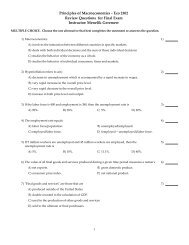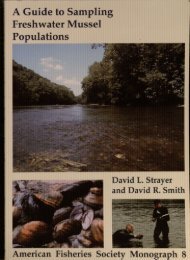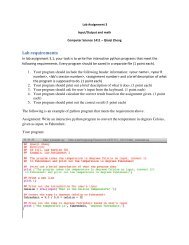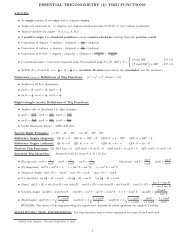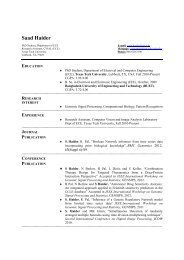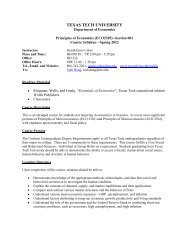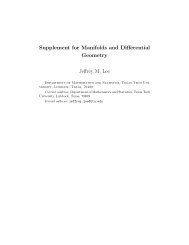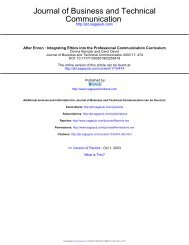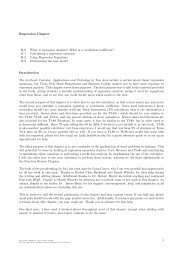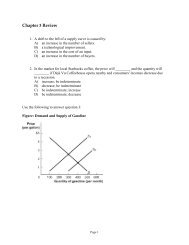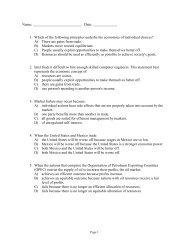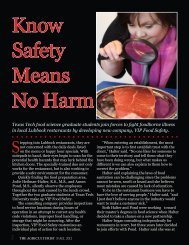Download - MyWeb - Texas Tech University
Download - MyWeb - Texas Tech University
Download - MyWeb - Texas Tech University
Create successful ePaper yourself
Turn your PDF publications into a flip-book with our unique Google optimized e-Paper software.
The 2012 Season of the Chan Chich Archaeological Project<br />
completely deserted, and rested by the Rio<br />
Bravo.” From that description, from his sketch<br />
of the settlement, and his caption on that<br />
sketch, which describes the water hole as the<br />
“only source of drinking water for villagers”<br />
(see Figure 4.2), I conclude that Kaxil Uinic<br />
village was located some distance from the<br />
Rio Bravo and not on it, as reported by Jones<br />
(1977:161). The “dirty water hole” mentioned<br />
by Thompson is a feature known as an aguada,<br />
and it is around this feature, not the river, that<br />
the village was located.<br />
The Archaeological Evidence<br />
When Chan Chich Lodge was opened in the late<br />
1980s, the presumed location of the village and<br />
its aguada was found by lodge staff, and until<br />
the late 1990s the trail to “Xaxe Venic”—an<br />
old logging road that passes through the Main<br />
Plaza of Chan Chich and heads west toward<br />
Guatemala—was kept opened and maintained<br />
by the lodge. Long-time lodge guide Hilberto<br />
Vasquez (personal communication, 2012)<br />
reported the lodge staff used to put bananas by<br />
the aguada to attract tapirs and that at one point<br />
a guide had found “the big stones the Maya<br />
women used to wash clothes” at the edge of the<br />
aguada and placed them at the base of a tree.<br />
The trail from the lodge passes through the<br />
prehistoric Kaxil Uinic ruins (see discussion<br />
below), but it had grown over with disuse<br />
since the late 1990s. To make matters worse,<br />
Hurricane Richard in 2010 had severely<br />
damaged the forest around Kaxil Uinic,<br />
destroying the canopy and littering the ground<br />
with massive tree falls. As Harris and Sisneros<br />
(this volume) report, the amount of debris<br />
forced us to alter our research design at the<br />
ruins.<br />
The lodge sent workers to reopen the trail and<br />
conduct initial clearing at the ruins prior to the<br />
arrival of the project staff in late May 2012.<br />
Once the project staff arrived and identified<br />
where we wanted to work, we employed lodge<br />
staff for several days to continue clearing the<br />
ruins. While that was going on, I asked one<br />
of the older employees at the lodge, Jorge<br />
Montuy, to look for the aguada, which the<br />
guides remembered as being several hundred<br />
meters south of the ruins. Montuy—who had<br />
incidentally accompanied us on our 1998<br />
hike—and another worker spent several hours<br />
cutting through dense growth and hurricane<br />
debris, ultimately reporting that afternoon<br />
that they had reached the aguada. Although it<br />
turned out that they had not actually reached<br />
the aguada, they were very close, and two other<br />
workers and I managed to locate it off their trail<br />
the next morning.<br />
The area around the aguada is a dense cohune<br />
forest made thicker by hurricane debris. The<br />
aguada is a natural depression on the landscape.<br />
By the end of the dry season in May 2012<br />
it retained water in its center (about 40 m in<br />
diameter) and was covered in aquatic vegetation<br />
(Figure 4.3). It is likely, based on the vegetation<br />
and topography, that the aguada doubles in<br />
diameter during the rainy season. The feature<br />
is approximately 500 m south/southeast of the<br />
prehistoric ruins of Kaxil Uinic, which places<br />
the village on Yalbac Ranch, the property that<br />
borders Gallon Jug Ranch to the south. A quick<br />
reconnaissance to the southern side of the<br />
feature found a fairly recent trail cut from the<br />
south and marked with orange flagging tape, so<br />
it is likely that workers on Yalbac Ranch have<br />
occasion to visit the aguada.<br />
The first indication that we were near the aguada<br />
was the large number of beer bottles scattered<br />
about the ground. In fact, glass bottles are the<br />
only indication of a historic settlement that we<br />
discovered, other than one metal pot. The few<br />
bottles that were collected or photographed<br />
include three beer bottles from the early 1900s<br />
(two from New York and one from Detroit)<br />
and a hair tonic bottle (Table 4.1). Church et<br />
al. (2010:187) report finding “a tremendous<br />
36



